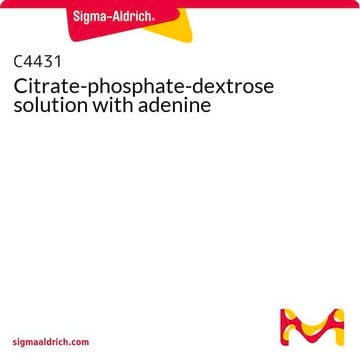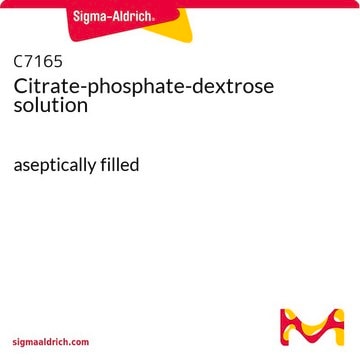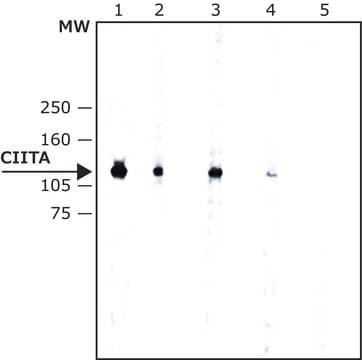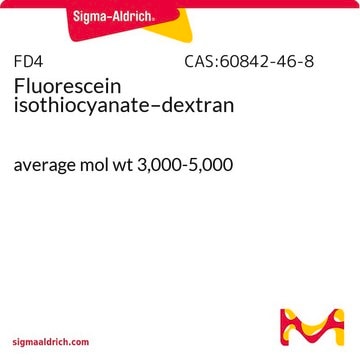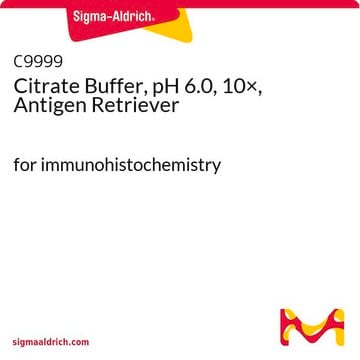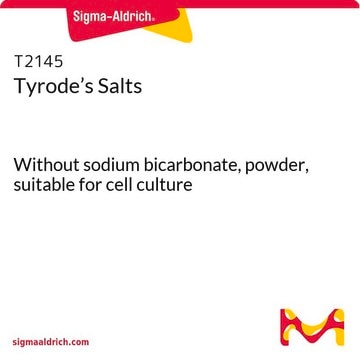Products may be shipped at a different temperature than the recommended long-term storage temperature. If the product quality is sensitive to short-term exposure to conditions other than the recommended long-term storage, it will be shipped on wet or dry-ice. If the product quality is NOT affected by short-term exposure to conditions other than the recommended long-term storage, it will be shipped at ambient temperature. As shipping routes are configured for minimum transit times, shipping at ambient temperature helps control shipping costs for our customers. For more information, please refer to the Storage and Transport Conditions document: https://www.sigmaaldrich.com/deepweb/assets/sigmaaldrich/marketing/global/documents/316/622/storage-transport-conditions-mk.pdf
C3821
Citrate-dextrose solution (ACD)
sterile-filtered
Synonym(s):
Acid citrate-dextrose, Anticoagulant citrate-dextrose
About This Item
Recommended Products
Related Categories
General description
Application
Biochem/physiol Actions
related product
Storage Class Code
12 - Non Combustible Liquids
WGK
WGK 1
Flash Point(F)
Not applicable
Flash Point(C)
Not applicable
Personal Protective Equipment
Choose from one of the most recent versions:
Certificates of Analysis (COA)
Don't see the Right Version?
If you require a particular version, you can look up a specific certificate by the Lot or Batch number.
Already Own This Product?
Find documentation for the products that you have recently purchased in the Document Library.
Customers Also Viewed
-
How is shipping temperature determined? And how is it related to the product storage temperature?
1 answer-
Helpful?
-
-
How can I determine the shelf life / expiration / retest date of this product?
1 answer-
If this product has an expiration or retest date, it will be shown on the Certificate of Analysis (COA, CofA). If there is no retest or expiration date listed on the product's COA, we do not have suitable stability data to determine a shelf life. For these products, the only date on the COA will be the release date; a retest, expiration, or use-by-date will not be displayed.
For all products, we recommend handling per defined conditions as printed in our product literature and website product descriptions. We recommend that products should be routinely inspected by customers to ensure they perform as expected.
For products without retest or expiration dates, our standard warranty of 1 year from the date of shipment is applicable.
For more information, please refer to the Product Dating Information document: https://www.sigmaaldrich.com/deepweb/assets/sigmaaldrich/marketing/global/documents/449/386/product-dating-information-mk.pdfHelpful?
-
-
Is the quality of the ACD solution affected if the bottles are left at ambient temperature (20°C in a temperature-controlled facility) for 48 hours, considering that they are typically required to be refrigerated?
1 answer-
The recommended storage temperature for the ACD solution is between 2-8°C. There is no formal data to suggest that the product can be stored outside of this range without affecting its quality. Additionally, the product is capable of being shipped at ambient temperature for a duration of up to 14 days.
Helpful?
-
-
What is the composition of this citrate-dextrose solution? Is it solution A or B as defined by the US Pharmacopeia?
1 answer-
The composition of the citrate-dextrose solution is as follows:
1. 22.00 g/L Citric Acid, trisodium salt, dihydrate (C3434)
2. 7.30 g/L Citric Acid, anhydrous (C0759)
3. 24.50 g/L D-(+) Glucose (G7528)
Based on this information, it is likely that the solution is ACD A, which is more commonly used than ACD B as defined by the US Pharmacopeia.Helpful?
-
-
What is the composition of product C3821, Citrate-dextrose solution (ACD)?
1 answer-
This corresponds to an ACD-A type solution. The composition of this product is as follows:
1. 22.00 g/L C3434, Citric Acid, trisodium salt, dihydrate
2. 7.30 g/L C0759, Citric Acid, anhydrous
3.24.50 g/L G7528, D-(+) Glucose.Helpful?
-
-
Is product C3821, Acid-Citrate-Dextrose, a concentrate? What ratio of product to whole blood is recommended?
1 answer-
C3821 can be considered a stock solution, and the bottle can be used multiple times. The ratio of ACD or Citrate Dextrose solution can vary from one source to another. A ratio of 1:11 is the more concentrated usage recommended, although dilutions as high as 1:16 are sometimes found in the literature. A good compromise might be a 1:12 dilution.
Given that there is no preservative in the solution, there is a possibility of contaminating the solution through routine use. Therefore, care should be taken to ensure that the solution does not become contaminated through routine use. The recommended storage temperature is 2-8°C.Helpful?
-
-
Can it used in prp preparation?
1 answer-
This product is not tested for platelet-rich plasma preparation, however, Acid Citrate-Detrose is commonly used in this procedure. There is no reason to suspect that this item would not be appropriate. This product is intended for research use only and is not suitable for IVD or therapeutic use.
Helpful?
-
-
Hi, I want to order ACD-A solution, I found you have ACD (C3821), I wonder if you can provide the content and concentration of your ACD so that I can compare and see what´s difference between your ACD and ACD-A
1 answer-
This product is equivalent to ACD- A solution.
The composition is as follows:
22.00 g/L C3434, Citric Acid, trisodium salt, dihydrate
7.30 g/L C0759, Citric Acid, anhydrous
24.50 g/L G7528, D-(+) Glucose (Dextrose)Helpful?
-
-
HI, I have this product Dextrose solution C3821-10X50ML. How long could I let it at room temps. It was shipped and keeping in shiping for 3 days. Thanks, Chenier
1 answer-
This product is shipped in ambient temperature. Once the product arrives to the address on the order, it is to be stored at 2-8°C by the end-user. Products shipped ambient but stored frozen or refrigerated should be stable in ambient temperature for up to two weeks. Please view this link for more information on Storage and Transport Conditions: https://www.sigmaaldrich.com/deepweb/assets/sigmaaldrich/marketing/global/documents/232/426/storage-transport-conditions-ms.pdf.
Helpful?
-
-
At what concentration should Product C3821, Citrate-dextrose solution, be used?
1 answer-
Use 1 part citrate dextrose solution to 9 parts blood.
Helpful?
-
Active Filters
Our team of scientists has experience in all areas of research including Life Science, Material Science, Chemical Synthesis, Chromatography, Analytical and many others.
Contact Technical Service